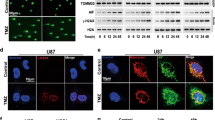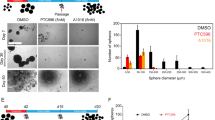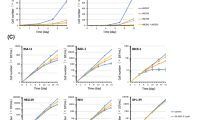Abstract
Background
Triple-negative breast cancer (TNBC) is characterized by high aggressiveness, heterogeneity, and poor prognosis. Programmed cell death 1 (PD-1)/programmed death-ligand 1 (PD-L1) inhibitors, a crucial type of immune checkpoint inhibitor therapy, have been proven to be a promising strategy for the TNBC treatment. Forebrain embryonic zinc finger 2 (FEZF2) is dysregulated in various cancers and participates in the tumor progression. However, its role and mechanism in TNBC remain unknown.
Objectives
To investigate whether FEZF2 is involved in the progression of TNBC via EZH2/PD-L1 axis.
Results
The expression of FEZF2 was downregulated in TNBC. Overexpression of FEZF2 reduced cell viability and enhanced cell apoptosis in both MDA-MB-231 and BT-549 cells. Meanwhile, upregulation of FEZF2 decreased the relative protein expression of EZH2 and PD-L1, which was restored by overexpression of EZH2 in both cells. Moreover, overexpression of PD-L1 neutralized the inhibitory effect of the FEZF2 overexpression on the cell viability in MDA-MB-231 and BT-549 cells. Furthermore, overexpression of FEZF2 reduced the tumor weight and volume, and increased numbers of CD8+ tumor-infiltrating lymphocytes in xenografted mice.
Conclusion
Overexpression of FEZF2 inhibited the proliferation and enhanced the apoptosis of TNBC cells through EZH2/PD-L1 axis, as well as promoted anti-tumor immunity in vivo.




Similar content being viewed by others
Data availability
The authors declare that all data supporting the findings of this study are available within the paper and any raw data can be obtained from the corresponding author upon request.
References
Chalakur-Ramireddy NKR, Pakala SB (2018) Combined drug therapeutic strategies for the effective treatment of triple negative breast cancer. Biosci Rep 38(1): BSR20171357. https://doi.org/10.1042/BSR20171357. PMID: 29298879; PMCID: PMC5789156
Chen Z et al (2018) Loss of Fezf2 promotes malignant progression of bladder cancer by regulating the NF-κB signaling pathway. Lab Investig 98:1225–1236
Chhabra R et al (2021) Characterization of stem cells from human exfoliated deciduous anterior teeth with varying levels of root resorption. J Clin Pediatr Dent 45:104–111
Fleisher B, Clarke C, Ait-Oudhia S (2016) Current advances in biomarkers for targeted therapy in triple-negative breast cancer. Breast Cancer (dove Med Press) 8:183–197
Gao B et al (2020) Overexpression of EZH2/NSD2 histone methyltransferase axis predicts poor prognosis and accelerates tumor progression in triple-negative breast cancer. Front Oncol 10:600514
He Y, Jiang Z, Chen C, Wang X (2018) Classification of triple-negative breast cancers based on Immunogenomic profiling. J Exp Clin Cancer Res 37:327
He Y et al (2021) Coniferyl aldehyde alleviates LPS-induced WI-38 cell apoptosis and inflammation injury via JAK2-STAT1 pathway in acute pneumonia. Allergol Immunopathol (madr) 49:72–77
Heeke AL, Tan AR (2021) Checkpoint inhibitor therapy for metastatic triple-negative breast cancer. Cancer Metastasis Rev 40:537–547
Hirata T et al (2006) Zinc-finger genes Fez and Fez-like function in the establishment of diencephalon subdivisions. Development 133:3993–4004
Lee, E. H. et al. (2022) Inhibition of TRPM7 suppresses migration and invasion of prostate cancer cells via inactivation of ERK1/2, Src and Akt pathway signaling. JOMH 18
Loi S et al (2021) The journey of tumor-infiltrating lymphocytes as a biomarker in breast cancer: clinical utility in an era of checkpoint inhibition. Ann Oncol 32:1236–1244
Miller KD et al (2022) Cancer treatment and survivorship statistics, 2022. CA Cancer J Clin 72:409–436
Mukherjee A, Park A, Davies KP (2022) PROL1 is essential for xenograft tumor development in mice injected with the human prostate cancer cell-line, LNCaP, and modulates cell migration and invasion. JOMH 18
O’Reilly EA et al (2015) The fate of chemoresistance in triple negative breast cancer (TNBC). BBA Clin 3:257–275
Peng D et al (2015) Epigenetic silencing of TH1-type chemokines shapes tumour immunity and immunotherapy. Nature 527:249–253
Schmid P et al (2018) Atezolizumab and nab-paclitaxel in advanced triple-negative breast cancer. N Engl J Med 379:2108–2121
Shi S et al (2022) Expression and clinical significance of CMTM6 and PD-L1 in triple-negative breast cancer. Biomed Res Int 2022:8118909
Shimizu T, Hibi M (2009) Formation and patterning of the forebrain and olfactory system by zinc-finger genes Fezf1 and Fezf2. Dev Growth Differ 51:221–231
Shu XS et al (2013) FEZF2, a novel 3p14 tumor suppressor gene, represses oncogene EZH2 and MDM2 expression and is frequently methylated in nasopharyngeal carcinoma. Carcinogenesis 34:1984–1993
Siegel RL, Miller KD, Fuchs HE, Jemal A (2022) Cancer statistics, 2022. CA Cancer J Clin 72:7–33
Song L et al (2020) Icariin-induced inhibition of SIRT6/NF-κB triggers redox mediated apoptosis and enhances anti-tumor immunity in triple-negative breast cancer. Cancer Sci 111:4242–4256
Sun C, Mezzadra R, Schumacher TN (2018) Regulation and function of the PD-L1 checkpoint. Immunity 48:434–452
Toyokawa G et al (2019) A positive correlation between the EZH2 and PD-L1 expression in resected lung adenocarcinomas. Ann Thorac Surg 107:393–400
**a C et al (2022) Cancer statistics in China and United States, 2022: profiles, trends, and determinants. Chin Med J (engl) 135:584–590
**ao Q, Lu R, He C, Zhou K (2021) Protective effect of USP22 against paraquat-induced lung injury via activation of SIRT1/NRF2 pathway. Signa Vitae 17:187–195
Yang N, Dong Z, Guo S (2012) Fezf2 regulates multilineage neuronal differentiation through activating basic helix–loop–helix and homeodomain genes in the zebrafish ventral forebrain. J Neurosci 32:10940–10948
Yang X, Gong J, Cai X, Yuan Y (2022) Overexpression of HIC1 plays a protective effect on renal cell injury caused by lipopolysaccharide by inhibiting IL-6/STAT3 pathway. Signa Vitae 18:147–153
Zhao Y et al (2019) EZH2 regulates PD-L1 expression via HIF-1α in non-small cell lung cancer cells. Biochem Biophys Res Commun 517:201–209
Zuccotti A et al (2014) The transcription factor Fezf2 directs the differentiation of neural stem cells in the subventricular zone toward a cortical phenotype. Proc Natl Acad Sci USA 111:10726–10731
Acknowledgements
Not applicable.
Funding
This work was supported by The Hospital Youth Fund, the First Affiliated Hospital of USTC (Grant no. 2020YJQN021).
Author information
Authors and Affiliations
Contributions
WL and HL designed the study and carried them out; WL, HL, WL, QZ, QZ, and DH supervised the data collection, analyzed the data, interpreted the data; WL and HL prepared the manuscript for publication and reviewed the draft of the manuscript. All authors have read and approved the manuscript.
Corresponding author
Ethics declarations
Conflict of interest
Wenyu Li declares that he/she has no conflict of interest; Hu Liu declares that he/she has no conflict of interest; Wenjuan Li declares that he/she has no conflict of interest; Qiujun Zhang declares that he/she has no conflict of interest; Qianyu Zhang declares that he/she has no conflict of interest; Dandan Hu declares that he/she has no conflict of interest.
Ethics approval
Ethical approval was obtained from the Laboratory Animals Ethics Committee of the First Affiliated Hospital of USTC (Approval no. 2022-N(A)-120).
Additional information
Publisher’s Note
Springer Nature remains neutral with regard to jurisdictional claims in published maps and institutional affiliations.
Rights and permissions
Springer Nature or its licensor (e.g. a society or other partner) holds exclusive rights to this article under a publishing agreement with the author(s) or other rightsholder(s); author self-archiving of the accepted manuscript version of this article is solely governed by the terms of such publishing agreement and applicable law.
About this article
Cite this article
Li, W., Liu, H., Li, W. et al. FEZF2 inhibits the growth of triple-negative breast cancer cells through EZH2/PD-L1 and enhances anti-tumor immunity in vivo. Mol. Cell. Toxicol. 20, 553–562 (2024). https://doi.org/10.1007/s13273-023-00368-9
Accepted:
Published:
Issue Date:
DOI: https://doi.org/10.1007/s13273-023-00368-9




